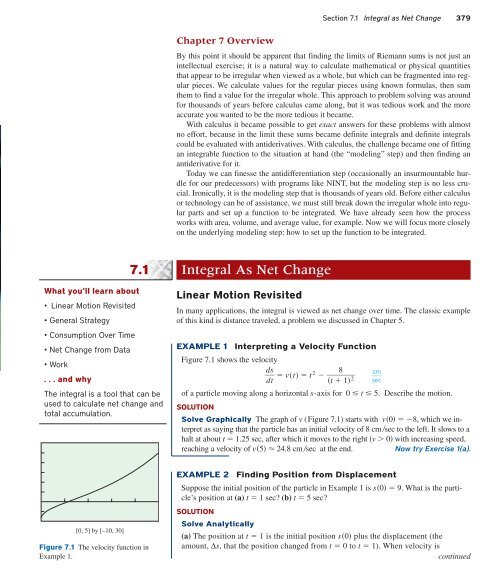Create successful ePaper yourself
Turn your PDF publications into a flip-book with our unique Google optimized e-Paper software.
Chapter 7 Overview<br />
Section 7.1 Integral as Net Change 379<br />
By this point it should be apparent that finding the limits of Riemann sums is not just an<br />
intellectual exercise; it is a natural way to calculate mathematical or physical quantities<br />
that appear to be irregular when viewed as a whole, but which can be fragmented into regular<br />
pieces. We calculate values for the regular pieces using known formulas, then sum<br />
them to find a value for the irregular whole. This approach to problem solving was around<br />
for thousands of years before calculus came along, but it was tedious work and the more<br />
accurate you wanted to be the more tedious it became.<br />
With calculus it became possible to get exact answers for these problems with almost<br />
no effort, because in the limit these sums became definite integrals and definite integrals<br />
could be evaluated with antiderivatives. With calculus, the challenge became one of fitting<br />
an integrable function to the situation at hand (the “modeling” step) and then finding an<br />
antiderivative for it.<br />
Today we can finesse the antidifferentiation step (occasionally an insurmountable hurdle<br />
for our predecessors) with programs like NINT, but the modeling step is no less crucial.<br />
Ironically, it is the modeling step that is thousands of years old. Before either calculus<br />
or technology can be of assistance, we must still break down the irregular whole into regular<br />
parts and set up a function to be integrated. We have already seen how the process<br />
works with area, volume, and average value, for example. Now we will focus more closely<br />
on the underlying modeling step: how to set up the function to be integrated.<br />
7.1<br />
What you’ll learn about<br />
• Linear Motion Revisited<br />
• General Strategy<br />
• Consumption Over Time<br />
• Net Change from Data<br />
• Work<br />
. . . and why<br />
The integral is a tool that can be<br />
used to calculate net change and<br />
total accumulation.<br />
Integral As Net Change<br />
Linear Motion Revisited<br />
In many applications, the integral is viewed as net change over time. The classic example<br />
of this kind is distance traveled, a problem we discussed in Chapter 5.<br />
EXAMPLE 1<br />
Interpreting a Velocity Function<br />
Figure 7.1 shows the velocity<br />
d s<br />
v(t) t<br />
dt<br />
2 c<br />
<br />
t <br />
81 2 m s ec<br />
of a particle moving along a horizontal s-axis for 0 t 5. Describe the motion.<br />
SOLUTION<br />
Solve Graphically The graph of v (Figure 7.1) starts with v0 8, which we interpret<br />
as saying that the particle has an initial velocity of 8 cmsec to the left. It slows to a<br />
halt at about t 1.25 sec, after which it moves to the right v 0 with increasing speed,<br />
reaching a velocity of v524.8 cmsec at the end.<br />
Now try Exercise 1(a).<br />
[0, 5] by [–10, 30]<br />
Figure 7.1 The velocity function in<br />
Example 1.<br />
EXAMPLE 2<br />
Finding Position from Displacement<br />
Suppose the initial position of the particle in Example 1 is s0 9. What is the particle’s<br />
position at (a) t 1 sec? (b) t 5 sec?<br />
SOLUTION<br />
Solve Analytically<br />
(a) The position at t 1 is the initial position s0 plus the displacement (the<br />
amount, Δs, that the position changed from t 0 to t 1). When velocity is<br />
continued












